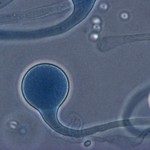Link to Pubmed [PMID] – 27419178
Open Forum Infect Dis 2016 Apr;3(2):ofw106
Background. Coelomycetes are rarely but increasingly reported in association with human infections involving mostly skin and subcutaneous tissues, both in immunocompetent and immunocompromised patients. Coelomycetes constitute a heterogeneous group of filamentous fungi with distinct morphological characteristics in culture, namely an ability to produce asexual spores within fruit bodies. Methods. We included all cases of proven primary cutaneous and/or subcutaneous infections due to coelomycetes received for identification at the French National Reference Center for Invasive Mycoses and Antifungals between 2005 and 2014. Eumycetoma, chromoblastomycosis, and disseminated infections were excluded. Results. Eighteen cases were analyzed. The median age was 60.5 years. In all cases, patients originated from tropical or subtropical areas. An underlying immunodepression was present in 89% of cases. Cutaneous and/or subcutaneous lesions, mainly nodules, abscesses, or infiltrated plaques, were observed in distal body areas. Isolates of different genera of coelomycetes were identified: Medicopsis (6), Paraconiothyrium (3), Gloniopsis (3), Diaporthe (3), Peyronellaea (2), Lasiodiplodia (1). Lesion treatment consisted of complete (10) or partial (2) surgical excision and/or the use of systemic antifungal therapy, namely voriconazole (5) and posaconazole (4). Literature review yielded 48 additional cases of cutaneous and/or subcutaneous infections due to coelomycetes. Conclusions. Infectious diseases physicians should suspect coelomycetes when observing cutaneous and/or subcutaneous infections in immunocompromised hosts from tropical areas; a sequence-based approach is crucial for strains identification but must be supported by consistent phenotypic features; surgical treatment should be favored for solitary, well limited lesions; new triazoles may be used in case of extensive lesions, especially in immunocompromised patients.





